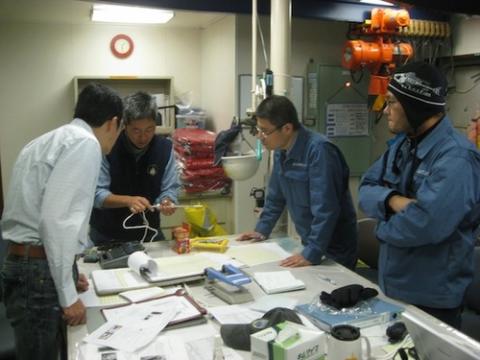One of the benefits of RV Mirai’s size is the capacity to complete observations across a wide variety of disciplines and provide real time assessment of the observations and samples taken combining the research into one big picture from numerous smaller ones. Research onboard runs from the sampling and studying the basic chemistry building blocks and chemical make up of the water column and atmosphere to the presence and distribution of animal and plant species. Each day at 1400 the lead researchers meet to discuss latest observations and finds and to discuss refined areas of focus or shifts in theories and ideas.
As an example, in her work thus far, Ana Aguilar-Islas from University of Alaska Fairbanks has determined that iron, one of the primary nutrients in the ocean food chain is not nearly as abundant in the Arctic Ocean as previously thought. It is at “normal” levels along the coast but in deeper water it soon virtually disappears in the upper water column. The result is less nutrient in the surface layers, thus less plankton and thus the deeper and darker blue of the ocean water. Sea life is restricted the the deeper more nutrient rich layers and along the North American coast line that would normally be expected. Aguilar-Islas’ work is matched against data collected confirming increased biomass in the more iron rich sea water.
We know that the primary circulation in the Arctic Ocean begins with dense Atlantic water entering via Fram Strait, that due to its high salinity and density, settles deeper and circulates clockwise around the Arctic Ocean and is described as “older” water. The “newer” Pacific Ocean water entering via the Bering Strait remains less dense, initially higher in nutrient and slightly warmer does not circulate as widely and generally is limited to the Canada Basin. Paradoxically the Atlantic water is warmer than the Pacific water, and it is the high density that causes it to sink.
One of the more interesting theories that is emerging during this cruise and has caught the interest in the Ice Navigator is that the increase in deeper warmer Atlantic water into the Arctic may be one of the primary causes for reduction in ice cover that is most evident along the Northern Sea Route. Generally speaking, the colder Pacific water is restricted to the Canadian Basin on the North American side of the Arctic Ocean. The warmer Atlantic water remains the predominant factor in the water column north of Russia and is in effect melting the pack from far below. Though science has accepted for some time the global model predictions that as climate change continues and the slow reduction in overall ice cover reduces, that there will be a progressive “opening” of sea lanes (the Northern Sea Route will be progressively more open to shipping, then the “cross-pole” ocean route and finally the Northwest passage), we have not fully understood the underlying causes. Simply passing this off to currents is not a complete enough answer. But combining factors such as increases in more intense storm activity that disturbs the ice cover, changes to seasonal temperature norms and the presence of warmer that previously understood deep water mass could explain the processes more completely.
Combined with that of many other international Arctic researchers, the work here is providing a better understanding of the forces at work in the fragile Arctic environment. As we better understand these forces we are able to make better decisions on how we delicately balance stewardship through protection and exploitation of the vast resources and waterways of the Arctic Ocean.
Capt David (Duke) Snider
Ice Navigator
RV Mirai
Photo: Chief Scientist Shigeto Nishino, second from right, discusses the day’s science plan with his team lead

